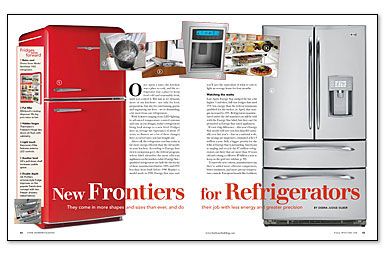New Frontiers for Refrigerators
They come in more shapes and sizes than ever, and do their job with less energy and greater precision.

Synopsis: With features ranging from LED lighting to advanced temperature-control systems and easy-access designs, today’s refrigerators bring food storage to a new level. Above all, the fridge you buy today is far more energy efficient than the old model in your kitchen. Fine Homebuilding editor Debra Silber explains the new Energy Star standard and what measures manufacturers are taking to make their fridges more efficient, including variable-speed compressors and better insulation and temperature controls. Custom cooling, air filtering, and specialty hinges that let the refrigerator sit flush with kitchen cabinetry are all on the menu. And there’s more, including refrigerator drawers and master suite “morning bars.” If you’re ready to ditch your fridge right now, Silber tells you how to recycle it.
Once upon a time, the kitchen was a place to cook, and the refrigerator was a place to keep food cold and reasonably fresh until you cooked it. But just as we demand more of our kitchens — not only for food preparation, but also for entertaining guests and organizing our lives — we’re demanding a lot more from our refrigerators.
With features ranging from LED lighting to advanced temperature-control systems and easy-access designs, today’s refrigerators bring food storage to a new level. Fridges have an average life expectancy of about 15 years, so chances are a lot of these changes have occurred since you last bought one.
Above all, the refrigerator you buy today is far more energy efficient than the old model in your kitchen. According to Energy Star (www.energystar.gov), the federal program whose label identifies the most-efficient appliances on the market, today’s energy Star-qualified refrigerators use half the electricity of those manufactured before 1993, and 65% less than those built before 1980. Replace a model made in 1990, Energy Star says, and you’ll save the equivalent of what it costs to light an average home for four months.
Watching the watts
Last April, Energy Star nudged the bar a bit higher. Until then, full-size fridges that used 15% less energy than the federal minimum qualified for the sticker; in April, that margin increased to 20%. Refrigerators manufactured under the old standard can still be sold with the Energy Star label, but they can’t be promoted as Energy Star-rated appliances.
It’s not a big difference — this year’s Energy Star model will save you less than $10 annually over last year’s — but on a national scale, the savings are impressive, estimated at $23.5 million a year. Still, a bigger priority for the folks at Energy Star is persuading Americans to unplug and recycle the 47 million refrigerators out there that are more than 10 years old and costing a collective $5 billion a year to keep on the grid.
To meet the new criteria, manufacturers say they’ve added more-efficient compressors, better insulation, and more-precise temperature controls. European brands like Liebherr, Siemens, Bosch, and Vestfrost, whose North American products are targeted at high-end consumers, employ some of the most sophisticated energy-saving technologies and, in a few cases, can boast of slightly higher energy savings. But you can buy an Energy Star-rated fridge at almost any price point. A no-frills, $800 top-freezer unit might lack the fancy gizmos of a French-door, LED-lit, variable-speed compressor-equipped luxury model, but still match it on the energy-use scale.
Compressors account for 83% of the energy used by refrigerators, so more efficient compressors generally translate to more efficient refrigerators. Variable-speed compressors save energy by operating at low speed during low-usage periods (such as overnight) and then compensate by running faster during periods of high usage — for example, when the door is repeatedly opened and shut as a family prepares breakfast. Still mostly limited to European brands and professional-style built-ins, variable-speed compressors are now showing up in some GE Profile and GE Monogram products, as well as Whirlpool’s high-end built-in lines. Officials at Energy Star say more manufacturers have indicated they might follow suit.
For more photos and details, click the View PDF button below:

























